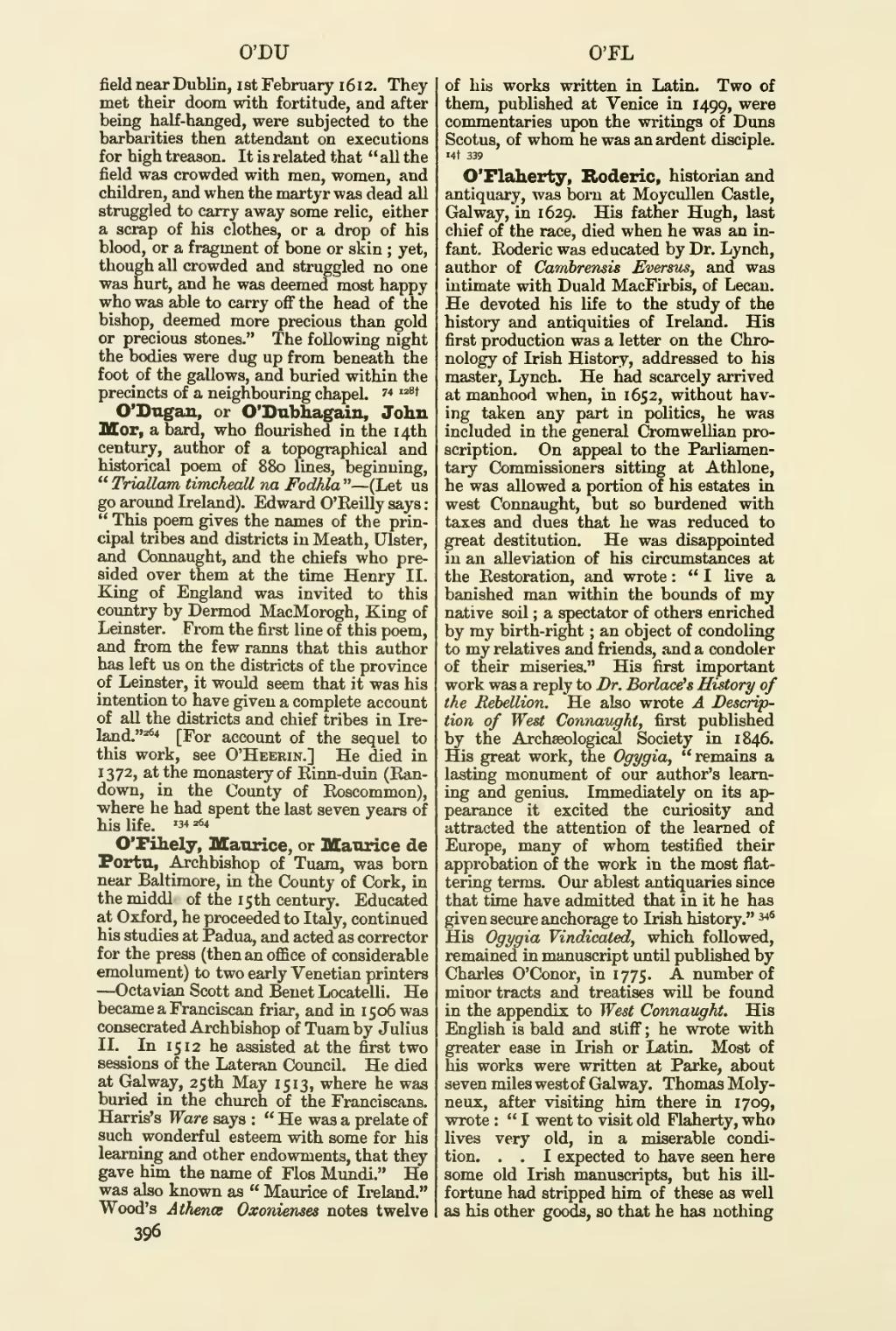O'DU
field near Dublin, i st February 1 6 1 2. They met their doom with fortitude, and after being half-hanged, were subjected to the barbarities then attendant on executions for high treason. It is related that "all the field was crowded with men, women, and children, and when the martyr was dead all struggled to carry away some relic, either a scrap of his clothes, or a drop of his blood, or a fragment of bone or skin ; yet, though all crowded and struggled no one was hurt, and he was deemed most happy who was able to carry off the head of the bishop, deemed more precious than gold or precious stones." The following night the bodies were dug up from beneath the foot of the gallows, and buried within the precincts of a neighbouring chapel. ?■* "^t
O'Dugan, or O'Dubhagain, John Mor, a bard, who flourished in the 14th century, author of a topographical and historical poem of 880 lines, beginning, "Triallam timchealt na Fodhla" — (Let us go around Ireland). Edward O'Eeilly says : "This poem gives the names of the prin- cipal tribes and districts in Meath, Ulster, and Connaught, and the chiefs who pre- sided over them at the time Henry II. King of England was invited to this country by Dermod MacMorogh, King of Leinster. From the first line of this poem, and from the few ranns that this author has left us on the districts of the province of Leinster, it would seem that it was his intention to have given a complete account of aU the districts and chief tribes in Ire- land."^ [For account of the sequel to this work, see O'Heerin.] He died in 1372, at the monastery of Rinn-duin (Ran- down, in the County of Roscommon), where he had spent the last seven years of his life. '34 264
O'Fihely, Maurice, or Maurice de Portti, Archbishop of Tuam, was born near Baltimore, in the County of Cork, in the middl of the 15 th century. Educated at Oxford, he proceeded to Italy, continued his studies at Padua, and acted as corrector for the press (then an office of considerable emolument) to two early Venetian printers — Octavian Scott and Benet Locatelli. He became a Franciscan friar, and in 15 06 was consecrated Archbishop of Tuam by Julius II. In 15 12 he assisted at the first two sessions of the Lateran Council. He died at Gal way, 25 th May 1513, where he was buried in the church of the Franciscans. Harris's Ware says : " He was a prelate of such wonderful esteem with some for his learning and other endowments, that they gave him the name of Flos Mundi." He was also known as " Maurice of Ireland." Wood's Athenoe Oxonienses notes twelve 396
OTL
of his works written in Latin. Two of them, published at Venice in 1499, ^^^e commentaries upon the writings of Duns Scotus, of whom he was an ardent disciple.
I4t 339
O'Plaherty, Roderic, historian and antiquary, was born at Moycullen Castle, Gal way, in 1629. His father Hugh, last cliief of the race, died when he was an in- fant. Roderic was educated by Dr. Lynch, author of Camhrensis Eversus, and was intimate with Duald MacFirbis, of Lecan. He devoted his life to the study of the history and antiquities of Ireland. His first production was a letter on the Chro- nology of Irish History, addressed to his master. Lynch. He had scarcely arrived at manhood when, in 1652, without hav- ing taken any part in politics, he was included in the general Cromwellian pro- scription. On appeal to the Parliamen- tary Commissioners sitting at Athlone, he was allowed a portion of his estates in west Connaught, but so burdened with taxes and dues that he was reduced to great destitution. He was disappointed in an alleviation of his circumstances at the Restoration, and wrote : "I live a banished man within the bounds of my native soil ; a spectator of others enriched by my birth- right ; an object of condoling to my relatives and friends, and a condoler of their miseries." His first important work was a reply to Dr. Borlace's History of the Rebellion. He also wrote A Descrip- tion of West Connaught, first published by the Archaeological Society in 1846. His great work, the Ogygia, "remains a lasting monument of our author's learn- ing and genius. Immediately on its ap- pearance it excited the curiosity and attracted the attention of the learned of Europe, many of whom testified their approbation of the work in the most flat- tering terms. Our ablest antiquaries since that time have admitted that in it he has given secure anchorage to Irish history." ^^ His Ogygia Vindicated, which followed, remained in manuscript until published by Charles O'Conor, in 1775. A number of minor tracts and treatises will be found in the appendix to West Connaught. His English is bald and stiff ; he wrote with greater ease in Irish or Latin. Most of his works were written at Parke, about seven miles west of Gal way. Thomas Moly- neux, after visiting him there in 1709, wrote : " I went to visit old Flaherty, who lives very old, in a miserable condi- tion. . . I expected to have seen here some old Irish manuscripts, but hia iU- fortune had stripped him of these as well as his other goods, so that he has nothing
